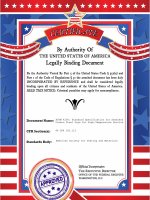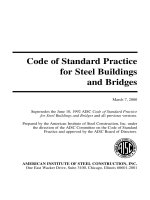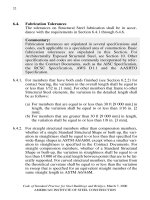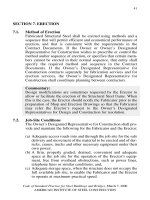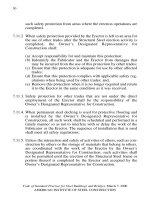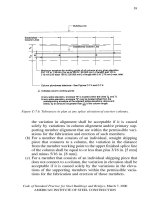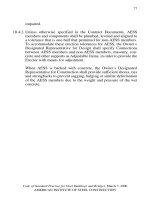ASTM D140/D140M-16 (2023) Standard Practice for Sampling Asphalt Materials
Bạn đang xem bản rút gọn của tài liệu. Xem và tải ngay bản đầy đủ của tài liệu tại đây (425.53 KB, 6 trang )
This international standard was developed in accordance with internationally recognized principles on standardization established in the Decision on Principles for the
Development of International Standards, Guides and Recommendations issued by the World Trade Organization Technical Barriers to Trade (TBT) Committee.
Designation: D140/D140M − 16 (Reapproved 2023)
Standard Practice for
Sampling Asphalt Materials1
This standard is issued under the fixed designation D140/D140M; the number immediately following the designation indicates the year
of original adoption or, in the case of revision, the year of last revision. A number in parentheses indicates the year of last reapproval.
A superscript epsilon (´) indicates an editorial change since the last revision or reapproval.
This standard has been approved for use by agencies of the U.S. Department of Defense.
1. Scope 4. Significance and Use
1.1 This practice applies to the sampling of asphalt materi- 4.1 Sampling is as important as testing, and precautions
als at points of manufacture, storage, or delivery. shall be taken to obtain samples to show the true nature and
condition of the materials.
1.2 The values stated in either SI units or inch-pound units
are to be regarded separately as standard. The values stated in 4.2 Samples are taken for either of the following two
each system may not be exact equivalents; therefore, each purposes:
system shall be used independently of the other. Combining
values from the two systems may result in nonconformance 4.2.1 To represent as nearly as possible an average of the
with the standard. bulk of the materials sampled, or
1.3 This standard does not purport to address all of the 4.2.2 To ascertain the maximum variation in characteristics
safety concerns, if any, associated with its use. It is the which the material possesses.
responsibility of the user of this standard to establish appro-
priate safety, health, and environmental practices and deter- 5. Precautions
mine the applicability of regulatory limitations prior to use.
5.1 Because of the numerous types and grades of asphalt
1.4 This international standard was developed in accor- materials that are alternately shipped and stored in the same or
dance with internationally recognized principles on standard- similar containers, the opportunity for contaminating these
ization established in the Decision on Principles for the containers with residues, precipitates, or cleaning solvents is
Development of International Standards, Guides and Recom- ever present. Numerous opportunities also exist for obtaining
mendations issued by the World Trade Organization Technical samples which are not strictly representative of the material or
Barriers to Trade (TBT) Committee. are contaminated after removal. Therefore, it is incumbent
upon the producer, transporter, user, and sampler to exercise
2. Referenced Documents continuous precaution in the sampling and handling of these
materials.
2.1 ASTM Standards:2
D8 Terminology Relating to Materials for Roads and Pave- 6. Selection of Samples
ments 6.1 Whenever practicable, asphalt materials shall be
D346/D346M Practice for Collection and Preparation of sampled at the point of manufacture or storage, and at such
time as to allow the tests controlling acceptance or rejection to
Coke Samples for Laboratory Analysis be made in advance of shipment.
3. Terminology 6.2 When the samples cannot be taken at the point of
manufacture or storage, they shall be taken from the shipment
3.1 Refer to Terminology D8. immediately upon delivery.
1 This practice is under the jurisdiction of ASTM Committee D04 on Road and 7. Size of Samples
Paving Materials and is the direct responsibility of Subcommittee D04.30 on
Methods of Sampling. 7.1 The sample size of liquid materials shall be as follows:
7.1.1 For routine laboratory examination and from barrels
Current edition approved Dec. 1, 2023. Published December 2023. Originally or drums, 500 mL to 1 L [1 pt to 1 qt].
approved in 1922. Last previous edition approved in 2016 as D140/D140M – 16. 7.1.2 From bulk storage, 4 L [1 gal].
DOI: 10.1520/D0140_D0140M-16R23. 7.1.3 For emulsified asphalts, 1 L [1 qt].
2 For referenced ASTM standards, visit the ASTM website, www.astm.org, or 7.2 The sample size of semisolid or solid materials shall be
contact ASTM Customer Service at For Annual Book of ASTM as follows:
Standards volume information, refer to the standard’s Document Summary page on
the ASTM website. 7.2.1 From barrels, drums, or cakes, 1 to 2 kg [2 to 3 lb].
Copyright © ASTM International, 100 Barr Harbor Drive, PO Box C700, West Conshohocken, PA 19428-2959. United States
1
D140/D140M − 16 (2023)
7.2.2 From crushed or powdered material in bulk or bags, 1 10.1.1 Sampling Valve Method—Valves shall be located,
to 2 kg [2 to 3 lb]. with easy and safe access provided, on the side of the tank with
the first in the top third of the tank but no higher than 1 m [3 ft]
8. Containers from the top; the second in the middle third of the tank; and the
third in the bottom third of the tank but no lower than 1 m [3 ft]
8.1 Types of Containers: from the bottom. A recommended design of the sampling valve
8.1.1 Containers for liquid asphalt materials, except emul- is shown in Fig. 1.
sified asphalts, shall be wide-mouth cans with lined screw caps
or triple-seal friction-top cans. 10.1.1.1 A minimum of 4 L [1 gal] of the product shall be
8.1.2 Containers for emulsified asphalts shall be wide- drawn from each sample valve and discarded before taking the
mouth jars or bottles made of plastic, or wide-mouth plastic- sample for test in a clean container.
lined cans with lined screw caps, or plastic-lined triple-seal
friction-top cans. 10.1.1.2 500 mL to 4 L [1 pt to 1 gal] shall be drawn from
8.1.3 Containers for crushed or powdered asphalt materials each sample valve for test.
shall be triple-seal friction-top cans or plastic sacks placed in
other containers suitable for handling. 10.1.2 Thief Sampler Method (not suitable for asphalt
cements)—Samples shall be taken in the top, middle, and lower
8.2 Size of Containers—The size of the container shall sections at levels indicated in 10.1.1, of the tank by lowering a
correspond to the required sample size. thief sampler into the material. A satisfactory type with
instructions for use is shown in Fig. 2.
9. Protection and Preservation of Samples
NOTE 2—Most asphalt materials in the liquid state are of such viscous
9.1 Sample containers shall be new. They shall not be and adhesive character that, after normal emptying of a container by
washed or rinsed or wiped with an oily cloth. If they contain pouring, the container retains enough material to cause significant
evidence of solder flux, or if they are not clean and dry, they contamination of any second samples secured before the container was
shall not be used. Top and container shall fit together tightly. thoroughly cleaned. The aforementioned properties of asphalt materials
also make container cleaning a difficult, tedious, and time-consuming task.
9.2 Care shall be taken to prevent the sample from becom-
ing contaminated. Immediately after filling, the container shall NOTE 3—The thief sampler described in Fig. 2 may be used for
be tightly sealed. repetitive sampling because significant sample contamination by previous
contents is avoided by the self-cleaning action provided by the passage of
9.3 The filled sample container shall not be submerged in material through the tube-shaped thief sampler which is open at both ends.
solvent, nor shall it be wiped with a solvent saturated cloth. If The practice of raising and lowering the sampler three or four times
cleaning is necessary, use a clean dry cloth. through a distance of a metre (several feet) at the sampling depth is
recommended.
9.4 Samples of emulsified asphalts shall be protected from
freezing by correct packaging. 10.1.3 Throwaway Container Method—Samples shall be
taken at top, middle, and lower levels by lowering into the
NOTE 1—When sampling emulsified asphalts, care should be taken not material a container in a suitable weighted holding device. The
to sample material under pressure as such resultant velocities tend to cause essential feature of the method is to use a clean container to
air entrapment which could result in erroneous test results. Any visual take the sample, pour this sample into another clean container,
bubbling of the material is one indication air has been entrapped. In and throw away the container used to take the sample from the
addition, the sampling container should be completely filled to minimize tank. A satisfactory type with instructions on how to use the
a skin formation at the air-emulsion interface. device is shown in Fig. 3.
9.5 Samples shall not be transferred from one container to
another except where required by the sampling procedure.
9.6 Immediately after filling, sealing, and cleaning, the
sampling containers shall be properly marked for identification
with a suitable marking pencil on the container itself, and not
on the lid. Labels or tags also may be used for identification if
they can be securely fastened to the container in such a manner
as to ensure that they will not be lost in transit. Labels or tags
shall not be attached to containers by using the lids to secure
them. All identification materials shall maintain their integrity
at temperatures up to 200 °C [390 °F].
9.6.1 The labeling of the sample must, at a minimum,
include an identification of the product or material type and the
date of sampling.
10. Sampling at Place of Manufacture FIG. 1 Typical Submerged Sampling Device
10.1 Vertical Tanks Not Capable of Being Agitated (Liquid
Materials or Materials Made Liquid by Heating) (800 m3
[5000 bbl] or more capacity)—Three sampling methods are
recommended (Note 2):
2
D140/D140M − 16 (2023)
11.3 A detachable fitting similar in design to the one shown
in Fig. 5 may be inserted in the discharge line. Before the
sample is taken, 4 L [1 gal] shall be drawn from this sampling
valve and discarded before taking the sample in a clean
container.
12. Sampling from Tankers and Barges
12.1 For liquid materials (including all cut-backs made
liquid by heating) top, middle, and lower samples shall be
taken using the methods as described in 10.1.2 and 10.1.3.
12.2 For all other materials made liquid by heating, a top
sample only shall be taken by the dip, thief, or throwaway
container method.
NOTE 1—This type sampler is lowered into the tank with bottom valve 13. Sampling from Pipe Lines During Loading or
open (there is no top closure). When the desired depth is reached, the Unloading
lowering chain is given a snap tug which closes the bottom valve. The
sampler is then withdrawn from the tank and the contents transferred to 13.1 When tankers and barges are being loaded or unloaded,
the sample container. This sampler may be used for repetitive sampling in samples may conveniently be taken from the pipe line through
the same tank. which the material is flowing by insertion of a sampling pipe
into a rising section of the pipe line on the discharge side of the
FIG. 2 Thief Sampler pump or in a completely filled line in which gravity creates the
material’s flow. A suitable in-line sampling pipe is shown in
10.1.4 The three samples from bulk storage tanks may be Fig. 5. The sampling pipe shall be not more than one eighth the
tested separately for consistency to detect stratification. They diameter of the pipe line and its opening should be turned to
may be combined, thoroughly mixed, and a 500 mL to 4 L [1 pt face the flow of the liquid. This pipe shall be provided with a
to 1 gal] sample may be taken for other tests that may be valve or plug cock and shall discharge into a sample receiver.
required for determining average characteristics of the mate- At least three 4 L [1 gal] samples shall be taken at uniform
rial. intervals throughout the entire loading or unloading. At the
completion of the loading or unloading, the individual 4 L
10.2 Bulk Storage Tanks (Liquid Materials or Materials [1 gal] samples shall be combined, thoroughly mixed without
Made Liquid by Heating) Equipped with Mechanical altering its characteristics, and a 4 L [1 gal] sample taken
Agitators—When the tank is equipped with operating mechani- therefrom.
cal agitators which by observation through the sampling or
inspection hatch are performing adequate mixing of the tank 13.2 When sampling tankers and barges 4000 m3 [25 000
contents, a single sample taken by any of the methods bbl] or less capacity, at least five 4 L [1 gal] samples shall be
described in 10.1.1, 10.1.2, or 10.1.3 will be satisfactory to use taken at uniform intervals throughout the entire loading or
for test purposes. unloading (4000 m3 [25 000 bbl] or larger capacity requires at
least ten 4 L [1 gal] samples). At completion of the loading or
11. Sampling from Tank Cars, Vehicle Tanks, Distributor unloading, the individual 4 L [1 gal] samples shall be
Trucks, or Recirculating Storage Tanks combined, thoroughly mixed in a manner designed to not alter
its characteristics, and a 4 L [1 gal] sample taken therefrom.
11.1 The sample may be taken from the sample valve or tap
if the tanks are provided with them. When such sampling 14. Sampling from Drums or Barrels
devices are required, they are to be built into the tank itself. A
sampling device of this type is shown in Fig. 1. Before the 14.1 After thorough mixing, samples of liquid asphalt
sample is taken, 4 L [1 gal] shall be drawn from the sample material from barrels or drums shall be secured by tube or thief
valve and discarded before taking the sample for test in a clean sampling by taking 1 L [1 qt] of material from packages
container. selected at random according to Section 15.
11.2 Samples of liquid materials and materials made liquid 15. Sampling Semisolid or Uncrushed Solid Materials
by heating may be taken by the dip method using a clean
wide-mouth or friction-top can in a suitable holder as shown in 15.1 Drums, Barrels, Cartons, and Bags—Where the lot of
Fig. 4. A clean container must be used to take each sample, and material to be sampled is obviously from a single run or batch
the material sampled shall then be transferred to another new of the producer, one package shall be selected at random and
and clean container for retention or testing sample. sampled as described below. Where the lot of material to be
sampled is not obviously from a single run or batch of the
producer, or where the single samples selected as described
above fails on test to conform to the requirements of the
specifications, a number of packages shall be selected at
random and equivalent to the cube root of the total number of
3
D140/D140M − 16 (2023)
NOTE 1—This type of sampler is lowered into the tank with the stopper in place. When the desired depth is reached, the stopper is removed by means
of the attached wire, cord, or chain and the container allowed to fill. Complete filling is indicated by the cessation of bubbles of air from the can at the
surface of the liquid. The sampler is then withdrawn from the tank and the contents poured into the clean sampler container. A clean can (bottle) must
be used for each sample taken.
FIG. 3 Throwaway Container Sampler
packages in the lot. The following table is given, showing the shall be melted and thoroughly mixed, and an average 4 L
number of samples to be selected for shipments of various [1 gal] sample taken from the combined material for examina-
sizes. tion. In case more than a single run or batch of the producer is
present and the batches can be clearly differentiated, a com-
Packages in Shipment Packages Selected posite 4 L [1 gal] sample shall be prepared for examination
2 to 8 2 from each batch. Where it is not possible to differentiate
9 to 27 3 between the various batches, each sample shall be examined
4 separately.
28 to 64 5
65 to 125 6 16. Sampling Crushed or Powdered Materials
126 to 216 7
217 to 343 8 16.1 Bulk Storage—Solid asphalt materials in crushed frag-
344 to 512 9 ments or powder shall be sampled in accordance with Practice
513 to 729 10 D346/D346M. The gross sample shall be not less than 25 kg
730 to 1000 11 [50 lb] from which shall be selected the 1 to 2 kg [2 to 3 lb]
1001 to 1331 sample for test.
Samples shall be taken from at least 75 mm [3 in.] below the 16.2 Drums, Barrels, Bags, and Cartons—Where the
surface and at least 75 mm [3 in.] from the side of the crushed or powdered material is in barrels, drums, or bags, a
container. If the material is hard enough to shatter, use a clean number of packages shall be selected at random as described in
hatchet. If the material is soft, use a broad, stiff putty knife. Section 15. A sample at least 0.5 kg [1.5 lb] in mass shall be
When more than one package in a lot is sampled, each
individual sample shall have a mass of not less than 0.1 kg
[0.25 lb] in weight. When the lot of material is obviously from
a single run or batch of the producer, all samples from the lot
4
D140/D140M − 16 (2023)
NOTE 1—Sampler with can secured in place is rapidly lowered into tank to 2 kg [2 to 3 lb] sample for test shall be selected as prescribed
to desired depth and allowed to fill with sample. The sampler is then in Practice D346/D346M.
withdrawn from the tank and the contents transferred to the sample
container. A clean container must be used to take each sample. 17. Sampling at Point of Shipment Delivery
FIG. 4 Dip Sampler 17.1 Sampling of asphalt materials shall be done as soon as
practicable after the asphalt material has arrived at plant site,
selected from near the center of each container to yield a gross storage site, or job destination or at the time of unloading.
sample weighing not less than 25 kg [50 lb] from which the 1
17.2 The required number of samples shall be taken from
each delivery of asphalt material. In the case of small delivery
units such as distributors, the samples shall be taken to
represent a maximum of 40 m3 [10 000 gal].
17.3 Sampling shall be done by one of the three following
methods:
17.3.1 In accordance with Section 10.
17.3.2 By bleeding through a sample valve or tap in the
transfer line during the unloading of the approximate middle
third of the load, or
17.3.3 By means of a sampling device inserted to a level of
approximately the middle third of the load or tank.
17.4 Tests for material acceptability shall be made on one of
the samples taken. The other samples are to be retained for
confirmation in the event the first sample tested should fail to
comply with requirements.
18. Keywords
18.1 asphalt materials; crushed materials; emulsified as-
phalts; liquid asphalts; powdered materials; sampling; semi-
solid materials; uncrushed solid materials
5
D140/D140M − 16 (2023)
FIG. 5 In-Line Asphalt Sampling Device
ASTM International takes no position respecting the validity of any patent rights asserted in connection with any item mentioned
in this standard. Users of this standard are expressly advised that determination of the validity of any such patent rights, and the risk
of infringement of such rights, are entirely their own responsibility.
This standard is subject to revision at any time by the responsible technical committee and must be reviewed every five years and
if not revised, either reapproved or withdrawn. Your comments are invited either for revision of this standard or for additional standards
and should be addressed to ASTM International Headquarters. Your comments will receive careful consideration at a meeting of the
responsible technical committee, which you may attend. If you feel that your comments have not received a fair hearing you should
make your views known to the ASTM Committee on Standards, at the address shown below.
This standard is copyrighted by ASTM International, 100 Barr Harbor Drive, PO Box C700, West Conshohocken, PA 19428-2959,
United States. Individual reprints (single or multiple copies) of this standard may be obtained by contacting ASTM at the above
address or at 610-832-9585 (phone), 610-832-9555 (fax), or (e-mail); or through the ASTM website
(www.astm.org). Permission rights to photocopy the standard may also be secured from the Copyright Clearance Center, 222
Rosewood Drive, Danvers, MA 01923, Tel: (978) 646-2600; />
6
